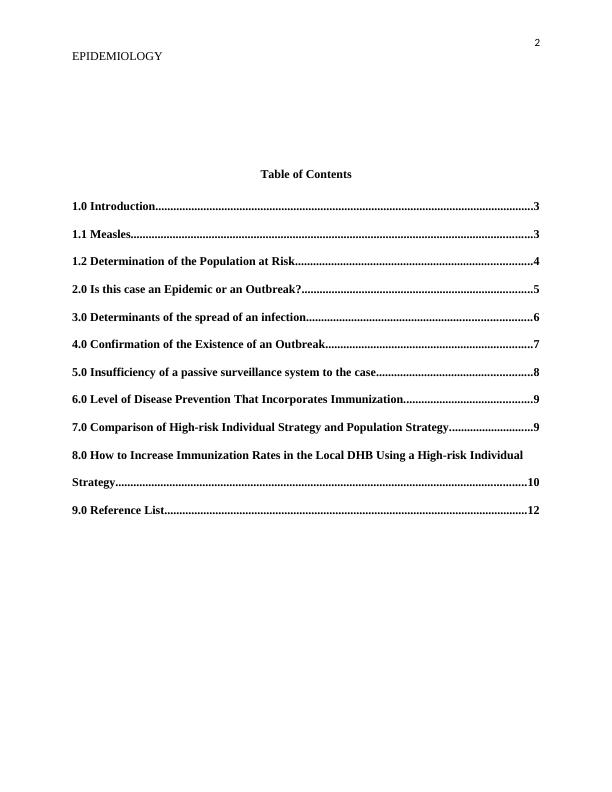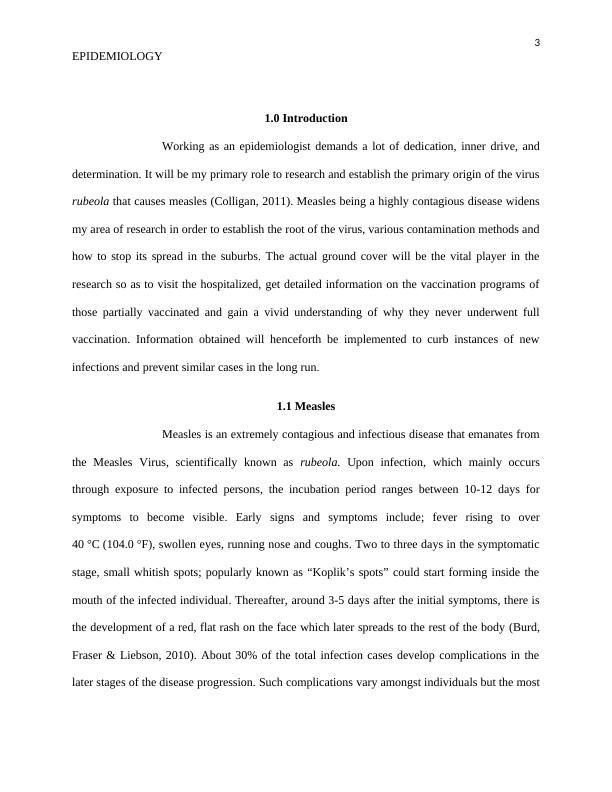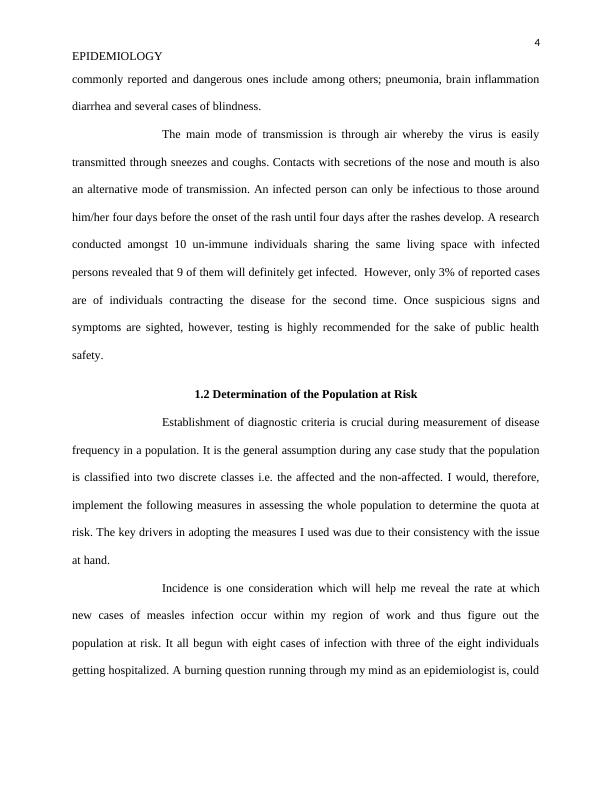Level of Disease Prevention - PDF
Added on 2021-05-27
13 Pages3552 Words327 Views
Running Head: EPIDEMIOLOGY1EpidemiologyNameInstitutional affiliation

2EPIDEMIOLOGYTable of Contents1.0 Introduction..............................................................................................................................31.1 Measles......................................................................................................................................31.2 Determination of the Population at Risk...............................................................................42.0 Is this case an Epidemic or an Outbreak?.............................................................................53.0 Determinants of the spread of an infection...........................................................................64.0 Confirmation of the Existence of an Outbreak.....................................................................75.0 Insufficiency of a passive surveillance system to the case....................................................86.0 Level of Disease Prevention That Incorporates Immunization...........................................97.0 Comparison of High-risk Individual Strategy and Population Strategy............................98.0 How to Increase Immunization Rates in the Local DHB Using a High-risk Individual Strategy.........................................................................................................................................109.0 Reference List.........................................................................................................................12

3EPIDEMIOLOGY1.0 IntroductionWorking as an epidemiologist demands a lot of dedication, inner drive, anddetermination. It will be my primary role to research and establish the primary origin of the virusrubeola that causes measles(Colligan, 2011). Measles being a highly contagious disease widensmy area of research in order to establish the root of the virus, various contamination methods andhow to stop its spread in the suburbs. The actual ground cover will be the vital player in theresearch so as to visit the hospitalized, get detailed information on the vaccination programs ofthose partially vaccinated and gain a vivid understanding of why they never underwent fullvaccination. Information obtained will henceforth be implemented to curb instances of newinfections and prevent similar cases in the long run.1.1 MeaslesMeasles is an extremely contagious and infectious disease that emanates fromthe Measles Virus, scientifically known as rubeola. Upon infection, which mainly occursthrough exposure to infected persons, the incubation period ranges between 10-12 days forsymptoms to become visible. Early signs and symptoms include; fever rising to over40°C(104.0°F), swollen eyes, running nose and coughs. Two to three days in the symptomaticstage, small whitish spots; popularly known as “Koplik’s spots” could start forming inside themouth of the infected individual. Thereafter, around 3-5 days after the initial symptoms, there isthe development of a red, flat rash on the face which later spreads to the rest of the body(Burd,Fraser & Liebson, 2010). About 30% of the total infection cases develop complications in thelater stages of the disease progression. Such complications vary amongst individuals but the most

4EPIDEMIOLOGYcommonly reported and dangerous ones include among others; pneumonia, brain inflammationdiarrhea and several cases of blindness. The main mode of transmission is through air whereby the virus is easilytransmitted through sneezes and coughs. Contacts with secretions of the nose and mouth is alsoan alternative mode of transmission. An infected person can only be infectious to those aroundhim/her four days before the onset of the rash until four days after the rashes develop. A researchconducted amongst 10 un-immune individuals sharing the same living space with infectedpersons revealed that 9 of them will definitely get infected. However, only 3% of reported casesare of individuals contracting the disease for the second time. Once suspicious signs andsymptoms are sighted, however, testing is highly recommended for the sake of public healthsafety.1.2 Determination of the Population at RiskEstablishment of diagnostic criteria is crucial during measurement of diseasefrequency in a population. It is the general assumption during any case study that the populationis classified into two discrete classes i.e. the affected and the non-affected. I would, therefore,implement the following measures in assessing the whole population to determine the quota atrisk. The key drivers in adopting the measures I used was due to their consistency with the issueat hand. Incidence is one consideration which will help me reveal the rate at whichnew cases of measles infection occur within my region of work and thus figure out thepopulation at risk. It all begun with eight cases of infection with three of the eight individualsgetting hospitalized. A burning question running through my mind as an epidemiologist is, could

End of preview
Want to access all the pages? Upload your documents or become a member.
Related Documents
Synopsis of an Article Assignmentlg...
|4
|859
|29
Measles: Etiology, Epidemiology, and Nursing Roleslg...
|9
|2551
|449
Microbiology - Case Study: What does the child have?lg...
|4
|795
|499
Dermatological Condition: Measles - Diagnosis, Prognosis and Treatment Optionslg...
|9
|3219
|169
Measles Virus Infection: A Case Studylg...
|5
|1116
|56
8 YOUNG CHILDREN AND INFANTS.lg...
|10
|2880
|1
